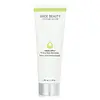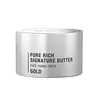What's inside
What's inside
 Key Ingredients
Key Ingredients

 Benefits
Benefits

 Concerns
Concerns

 Ingredients Side-by-side
Ingredients Side-by-side

Aloe Barbadensis Leaf Juice
Skin ConditioningPyrus Malus Juice
Skin ConditioningVitis Vinifera
MaskingCitrus Limon Juice
Skin ConditioningGlycerin
HumectantHelianthus Annuus Seed Oil
EmollientEthylhexyl Palmitate
EmollientCaprylic/Capric Triglyceride
MaskingGlyceryl Stearate
EmollientStearic Acid
CleansingPalmitoyl Pentapeptide-4
Skin ConditioningAcetyl Hexapeptide-8
HumectantCetearyl Alcohol
EmollientButyrospermum Parkii Butter
Skin ConditioningSimmondsia Chinensis Seed Oil
EmollientOenothera Biennis Oil
EmollientLinum Usitatissimum Seed Oil
PerfumingBorago Officinalis Seed Oil
EmollientXanthan Gum
EmulsifyingPanthenol
Skin ConditioningMagnesium Ascorbyl Phosphate
AntioxidantAllantoin
Skin ConditioningTocopherol
AntioxidantEthylhexylglycerin
Skin ConditioningSodium Benzoate
MaskingPotassium Sorbate
PreservativeCitrus Reticulata Peel Oil
MaskingLitsea Cubeba Fruit Oil
MaskingJuniperus Virginiana Oil
MaskingAloe Barbadensis Leaf Juice, Pyrus Malus Juice, Vitis Vinifera, Citrus Limon Juice, Glycerin, Helianthus Annuus Seed Oil, Ethylhexyl Palmitate, Caprylic/Capric Triglyceride, Glyceryl Stearate, Stearic Acid, Palmitoyl Pentapeptide-4, Acetyl Hexapeptide-8, Cetearyl Alcohol, Butyrospermum Parkii Butter, Simmondsia Chinensis Seed Oil, Oenothera Biennis Oil, Linum Usitatissimum Seed Oil, Borago Officinalis Seed Oil, Xanthan Gum, Panthenol, Magnesium Ascorbyl Phosphate, Allantoin, Tocopherol, Ethylhexylglycerin, Sodium Benzoate, Potassium Sorbate, Citrus Reticulata Peel Oil, Litsea Cubeba Fruit Oil, Juniperus Virginiana Oil
Water
Skin ConditioningCaprylic/Capric Triglyceride
MaskingDipropylene Glycol
HumectantGlycerin
HumectantButyrospermum Parkii Butter
Skin ConditioningCyclopentasiloxane
EmollientHelianthus Annuus Seed Oil
EmollientTheobroma Cacao Seed Butter
EmollientStearyl Alcohol
EmollientCetyl Alcohol
EmollientGlyceryl Stearate
EmollientPEG-100 Stearate
Ceramide NP
Skin ConditioningNiacinamide
SmoothingPanthenol
Skin ConditioningSodium Hyaluronate
HumectantHydrolyzed Collagen
EmollientMoringa Oleifera Seed Oil
EmollientCamellia Sinensis Seed Oil
HumectantCetyl Palmitate
EmollientSorbitan Palmitate
EmulsifyingSorbitan Olivate
EmulsifyingCeteareth-20
CleansingAmmonium Acryloyldimethyltaurate/Beheneth-25 Methacrylate Crosspolymer
Emulsion StabilisingSodium Polyacrylate
AbsorbentCetyl Ethylhexanoate
EmollientEthylhexyl Palmitate
EmollientHydrogenated Lecithin
EmulsifyingCalcium Titanium Borosilicate
AbrasiveAlgin
Masking1,2-Hexanediol
Skin ConditioningPhenoxyethanol
PreservativeButylene Glycol
HumectantTocopheryl Acetate
AntioxidantEthylhexylglycerin
Skin ConditioningTitanium Dioxide
Cosmetic ColorantTin Oxide
AbrasiveDisodium EDTA
Parfum
MaskingCI 77492
Cosmetic ColorantCI 77480
Cosmetic ColorantWater, Caprylic/Capric Triglyceride, Dipropylene Glycol, Glycerin, Butyrospermum Parkii Butter, Cyclopentasiloxane, Helianthus Annuus Seed Oil, Theobroma Cacao Seed Butter, Stearyl Alcohol, Cetyl Alcohol, Glyceryl Stearate, PEG-100 Stearate, Ceramide NP, Niacinamide, Panthenol, Sodium Hyaluronate, Hydrolyzed Collagen, Moringa Oleifera Seed Oil, Camellia Sinensis Seed Oil, Cetyl Palmitate, Sorbitan Palmitate, Sorbitan Olivate, Ceteareth-20, Ammonium Acryloyldimethyltaurate/Beheneth-25 Methacrylate Crosspolymer, Sodium Polyacrylate, Cetyl Ethylhexanoate, Ethylhexyl Palmitate, Hydrogenated Lecithin, Calcium Titanium Borosilicate, Algin, 1,2-Hexanediol, Phenoxyethanol, Butylene Glycol, Tocopheryl Acetate, Ethylhexylglycerin, Titanium Dioxide, Tin Oxide, Disodium EDTA, Parfum, CI 77492, CI 77480
Ingredients Explained
These ingredients are found in both products.
Ingredients higher up in an ingredient list are typically present in a larger amount.
This ingredient is also known as shea butter. It is an effective skin hydrator and emollient.
Emollients help soothe and soften your skin. It does this by creating a protective film on your skin. This barrier helps trap moisture and keeps your skin hydrated. Emollients may be effective at treating dry or itchy skin.
Shea butter is rich in antioxidants. Antioxidants help fight free-radicals, or molecules that may harm the body. It is also full of fatty acids including stearic acid and linoleic acid. These acids help replenish the skin and keep skin moisturized.
While Shea Butter has an SPF rating of about 3-4, it is not a sunscreen replacement.
Shea butter may not be fungal acne safe. We recommend speaking with a professional if you have any concerns.
Learn more about Butyrospermum Parkii ButterThis ingredient is an emollient, solvent, and texture enhancer. It is considered a skin-softener by helping the skin prevent moisture loss.
It helps thicken a product's formula and makes it easier to spread by dissolving clumping compounds.
Caprylic Triglyceride is made by combining glycerin with coconut oil, forming a clear liquid.
While there is an assumption Caprylic Triglyceride can clog pores due to it being derived from coconut oil, there is no research supporting this.
Learn more about Caprylic/Capric TriglycerideEthylhexyl Palmitate, also known as octyl palmitate, is created from 2-ethylhexyl alcohol and palmitic acid. It is a fatty acid ester.
The fatty acid content of Ethylhexyl Palmitate makes it an emollient. Emollients help soften and hydrate your skin by trapping moisture within.
Ethylhexyl Palmitate is also used to help improve the texture of cosmetics. It helps other ingredient dissolve in products and help disperse ingredients more evenly.
You'll likely find this ingredient in sunscreen, as it is often used to mix UV-blocking ingredients such as avobenzone and ethylhexyl triazone.
It can also help stabilize the fragrances in a product as a fragrance fixative.
Ethylhexyl Palmitate can be used to substitute mineral oil.
Due to its high fatty acid content, it may not be fungal-acne safe.
Learn more about Ethylhexyl PalmitateEthylhexylglycerin (we can't pronounce this either) is commonly used as a preservative and skin softener. It is derived from glyceryl.
You might see Ethylhexylglycerin often paired with other preservatives such as phenoxyethanol. Ethylhexylglycerin has been found to increase the effectiveness of these other preservatives.
Glycerin is already naturally found in your skin. It helps moisturize and protect your skin.
A study from 2016 found glycerin to be more effective as a humectant than AHAs and hyaluronic acid.
As a humectant, it helps the skin stay hydrated by pulling moisture to your skin. The low molecular weight of glycerin allows it to pull moisture into the deeper layers of your skin.
Hydrated skin improves your skin barrier; Your skin barrier helps protect against irritants and bacteria.
Glycerin has also been found to have antimicrobial and antiviral properties. Due to these properties, glycerin is often used in wound and burn treatments.
In cosmetics, glycerin is usually derived from plants such as soybean or palm. However, it can also be sourced from animals, such as tallow or animal fat.
This ingredient is organic, colorless, odorless, and non-toxic.
Glycerin is the name for this ingredient in American English. British English uses Glycerol/Glycerine.
Learn more about GlycerinGlyceryl Stearate is a mix of glycerin and stearic acid.
It is used to stabilize the mixing of water and oil ingredients. By preventing these ingredients from separating, it can help elongate shelf life. It can also help thicken the product's texture.
As an emollient, it helps soften skin and supports barrier-replenishing ingredients.
In cosmetics, Glyceryl Stearate is often made from vegetable oils or synthetically produced.
This ingredient may not be fungal-acne safe
Fun fact: The human body also creates Glyceryl Stearate naturally.
Learn more about Glyceryl StearateHelianthus Annuus Seed Oil is the oil derived from the seeds of a Sunflower. Sunflower seed oil is non-fragrant. It is an emollient, meaning it helps to soften the skin.
Sunflower seed oil contains many fatty acids. The fatty acids found in sunflower seeds include (from highest amount to least): linoleic acid, myristic acid, palmitic acid, stearic acid, arachidic acid, oleic acid, and linolenic acid.
These fatty acids help the skin create ceramides. Ceramides play a role in repairing the skin barrier.
Helianthus Annuus Seed Oil helps moisturize the skin. This in turn helps the skin look more rejuvenated and smoother.
Sunflowers are rich in vitamin E.
Historians believe Indigenous cultures of North America domesticated sunflowers before corn. Thus they relied on sunflower oil for a variety of uses. One such use is moisturizing skin and hair.
Sunflower seed oil may not be fungal acne safe. We recommend speaking with a professional if you have any concerns.
Learn more about Helianthus Annuus Seed OilPanthenol is a common ingredient that helps hydrate and soothe the skin. It is found naturally in our skin and hair.
There are two forms of panthenol: D and L.
D-panthenol is also known as dexpanthenol. Most cosmetics use dexpanthenol or a mixture of D and L-panthenol.
Panthenol is famous due to its ability to go deeper into the skin's layers. Using this ingredient has numerous pros (and no cons):
Like hyaluronic acid, panthenol is a humectant. Humectants are able to bind and hold large amounts of water to keep skin hydrated.
This ingredient works well for wound healing. It works by increasing tissue in the wound and helps close open wounds.
Once oxidized, panthenol converts to pantothenic acid. Panthothenic acid is found in all living cells.
This ingredient is also referred to as pro-vitamin B5.
Learn more about Panthenol